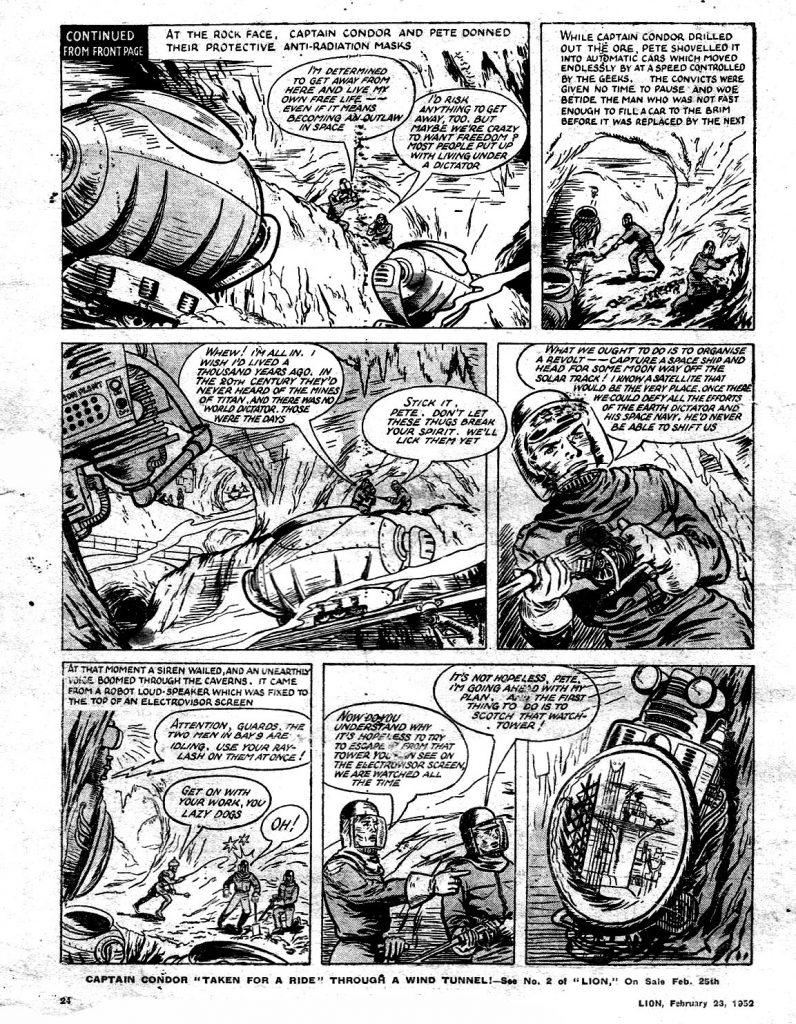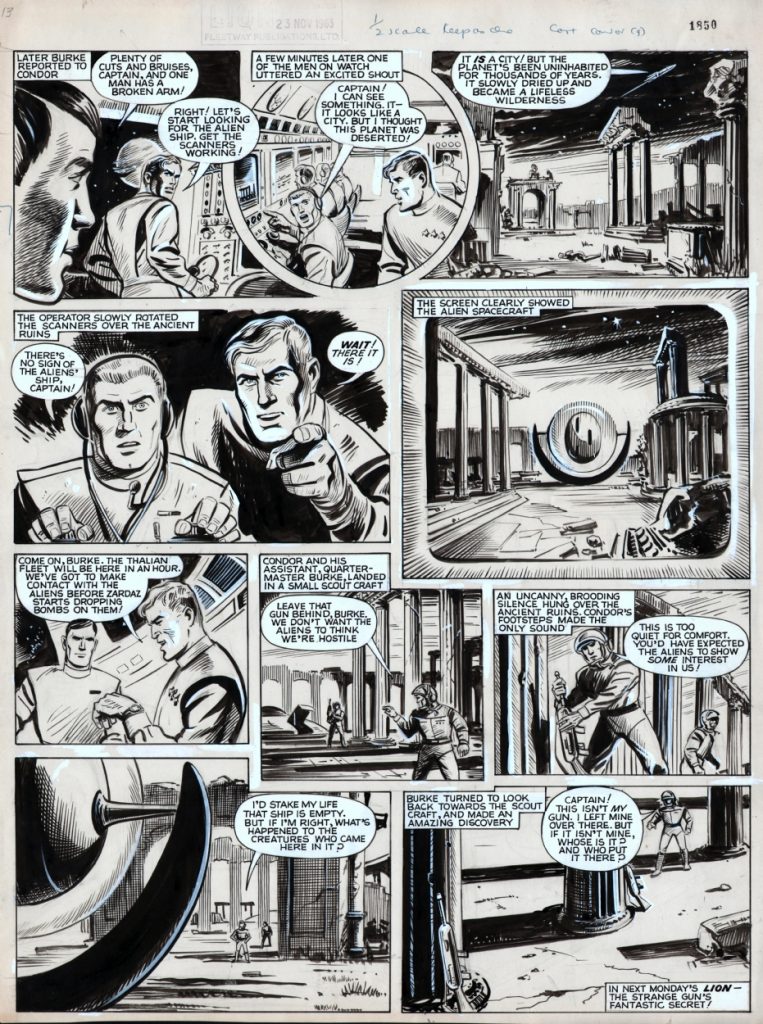
Dan Dare, star of Eagle and early 2000AD, whose adventures extend to radio, award-winning adventures and more, is a British comics hero up there with Roy of the Rovers, Judge Dredd, Fungus the Bogeyman, Rupert the Bear and Dennis the Menace, in terms of public awareness beyond comics fandom. But at the height of his success in the 1950s he spawned many rivals – including Captain Condor, lead hero of Lion, the boys adventure comic published by Amalgamated Press and now owned by Rebellion.
Lion was the weekly adventure comic launched by Amalgamated Press in response to the success of the ground-breaking Eagle and Captain Condor was its cover star from the very first issue published in February 1952. It was also home to “Robot Archie”, initially titled “The Jungle Robot“, created by writer E. George Cowan and artist F A Philpott (Ted Kearon did not take over the strip until 1958); and World War Two hero “Paddy Payne“, written by Val Holding and drawn by Joe Colquhoun, the latter quickly establishing itself as the comic’s most popular strip.
Commissioned at the direction of Lion editor Reg Eves, under orders from senior management, Captain Condor, aided by trusty assistant Quartermaster Burke, was the creation of stalwart writer Frank S. Pepper, who had been selling stories to various boys story papers since the 1930s. His credits also include the creation of Rockfist Rogan for Champion, under the pseudonym Hal Wilton, in 1937, which he wrote for over 20 years. He would go on to create Roy of the Rovers for Tiger and, much later, Steel Commando for Thunder in the 1970s and he also wrote the Lion strip “Spellbinder” and “Jet-Ace Logan“, in both The Comet and Tiger.
Future Eagle and Tiger editor Barrie Tomlinson recalls meeting Frank in the early 1960s in his book Comic Book Hero. “Frank would frequently travel up to London from his home in Devon to talk over stories with the editors. I was thrilled to meet him and listen to the way he talked about his stories and see the way his scripts were set out.”
“Reg Eves had no interest in Science Fiction, had never run any in any of his papers, and had never read any”, Pepper told one interviewer, quoted by Andrew Darlington in an article for the Australian fanzine Mentor, back in 1994. “But I understand that he was under orders from the ‘front office’ to put a Space Hero on the cover as a competitor to Dan Dare.
“‘Do what you like Frank’, he said, ‘I don’t know anything about it’.”
Captain Condor debuted in the story “The Outlaw of Space“, as a prisoner of the Dictator of the Planets in a uranium mine on Titan, one of Saturn’s moons, in 3000AD, unjustly incarcerated for refusing to serve the tyrannical ruler of the solar system. Of course, he quickly escaped, leading a resistance movement that would see the overthrow the Dictator after 38 issues, becoming a commander in the New Special Space Patrol.
‘When I was given the job, I felt that our juvenile readers could be very unsophisticated as far as science fiction was concerned,” Pepper recalled. “It was necessary to give them a story with strong elements to which they could relate – themes they already knew.
“I therefore chose the one about the unjustly imprisoned hero who escapes from prison and becomes an outlaw. But instead of escaping from Alcatraz or Devil’s Island, I simply pushed the prison into space”.


The early “Captain Condor” adventures were drawn by Ronald Forbes, a war veteran perhaps better known for his work for rival publisher DC Thomson on strip’s for Rover, and, much later, Bunty, Judy and Jackie. His work on “Captain Condor” is not highly regarded, despite being the lead strip in the comic but he was not replaced for some time, initially by Neville Wilson, perhaps better known for his work on DC Thomson titles such as Scoop and Spike.
Other artists who worked on the strip include Leslie Waller, who also illustrated two text stories and one comic strip that appeared in the 1966 Dalek Outer Space Book and also drew a couple of strips for Knockout and Tiger, before emigrating to Canada; and Dan Dare artist Keith Watson.


With story titles that might have pulled straight from the weekly cinema club serials such as “Captain Condor’s Robot Raiders“, the character was a huge success, as was Lion, gaining a solid readership. Like Eagle and similar picture strip-led titles, it helped cement the success of the weekly comics format over their more traditional text story led rival papers on the news stand.

Although he was ousted as cover star by “Paddy Payne” in July 1957, a strip well known for stories drawn by “Charley’s War” artist Joe Colquhoun, Captain Condor remained the cover star of the Lion annual for much of the 1950s and enjoyed continuous publication in new stories until April 1964, but that run came to an end with “Captain Condor in Shipwreck“. He would return after a short break in a series of text stories, and more strips between 1965 and 1966.


As tastes in heroes changed, Captain Condor’s original stories – some drawn by Brian Lewis – were brought to a halt in favour of reprinting earlier stories, both in Lion between 1968 and 1969, making way for “Dan Dare” when Lion and Eagle merged; and in Ranger, although new stories were commissioned for the 1971 Lion Summer Special and again in 1980.


He also featured in Look and Learn in 1966, renamed as interplanetary investigator Rip Solar, had adventures reprinted in two early issues of Lion Picture Library, a title launched in 1963, and a reprint appearance in the 1980 Starlord annual.
Dan Dare really monopolised British comics space-based merchandise in the 1950s – but as Richard Sheaf has noted on his Boys Adventure Comics blog, Captain Condor was not above getting in on the merchandise action. Items included a wrist watch, produced by Timex and for which Frank S. Pepper wisely kept copyright and earned royalties; handkerchiefs; and toy figures (although “Winco Condar’s Interplanetary Spacemen” were almost certainly not have been official).

In 1992, long after Captain Condor’s final appearance in comics, Corgi released Corgi Comic Classics #96961 – The Lion Captain Condor Panel Bus, Limited Edition. (There was another Lion van, too, made by Oxford Diecast, but its use of “Captain Condor” is not nearly as impressive.


“Captain Condor” certainly doesn’t enjoy the same kind of resonance as other space heroes among British comic fans, and the number of artists assigned to draw Captain Condor later in his run (including the brilliant Geoff Campion) certainly didn’t help give the character any kind of unified look. (In 1994, in his article for Mentor, Andrew Darlington rightly described Captain Condor as a character “in search of an artist”).
Martin Crookall, looking back on the history of Lion, is even more savage. “Among old fans of British boys comics of a certain generation, Condor has a reputation second only to Dan Dare himself,” he notes. “Not that there were many such rivals, the only other serious contender being Tiger’s Jet Ace Logan. But after a decade plus of his adventures I have to ask why. Neither Condor nor his longstanding assistant Quartermaster Burke (what is an officer who organises stores doing as Condor’s assistant troubleshooter?) have an atom of personality, their stories do not rise above space opera, and there is neither continuity, logic nor any consistency between adventures.”
While his universe certainly hasn’t had the same kind of longevity or appreciation awarded Frank Hampson and team’s work developing Dan Dare, and the art in some stories disappoints, there’s no doubt that while Lion was a “cheap and cheerful” rival to Eagle, “Captain Condor” and undoubtedly helped the weekly comic’s early – and lasting – success.
WEB LINKS
• International Hero – Captain Condor
• Captain Condor original art on ComicArtFans
• Lambiek: Captain Condor Artist Geoff Campion
• Lambiek: Captain Condor Artist Brian Lewis
• Lambiek: Captain Condor Artist Keith Watson
• Keith Watson – Independent Obituary by Alan Vince
• Moonbase Central: Lion 1950s Annual covers featuring Captain Condor
• Boys Adventure Comics – Captain Condor handkerchiefs items here and here
• Captain Condor tagged items on Amazon.co.uk (Affiliate Link)
Captain Condor, Lion © Rebellion Publishing Ltd.
With thanks to Mark Chapman, Andrew Darlington for his article and ‘Captain Condor’ story guide for Mentor #84 – 1994, Philip Rushton, Richard Sheaf and Andrew Wood at LittleWheels.net
The founder of downthetubes, which he established in 1998. John works as a comics and magazine editor, writer, and on promotional work for the Lakes International Comic Art Festival. He is currently editor of Star Trek Explorer, published by Titan – his third tour of duty on the title originally titled Star Trek Magazine.
Working in British comics publishing since the 1980s, his credits include editor of titles such as Doctor Who Magazine, Babylon 5 Magazine, and more. He also edited the comics anthology STRIP Magazine and edited several audio comics for ROK Comics. He has also edited several comic collections, including volumes of “Charley’s War” and “Dan Dare”.
He’s the writer of “Pilgrim: Secrets and Lies” for B7 Comics; “Crucible”, a creator-owned project with 2000AD artist Smuzz; and “Death Duty” and “Skow Dogs” with Dave Hailwood.
Categories: British Comics, Creating Comics, downthetubes Comics News, downthetubes News

 The SEQUENT’ULL Interviews: Dan White
The SEQUENT’ULL Interviews: Dan White  Sports comic highlights an immortal rugby match
Sports comic highlights an immortal rugby match  The SEQUENT’ULL Interviews: Michelle Freeman
The SEQUENT’ULL Interviews: Michelle Freeman  The SEQUENT’ULL Interviews: Colossive Press
The SEQUENT’ULL Interviews: Colossive Press